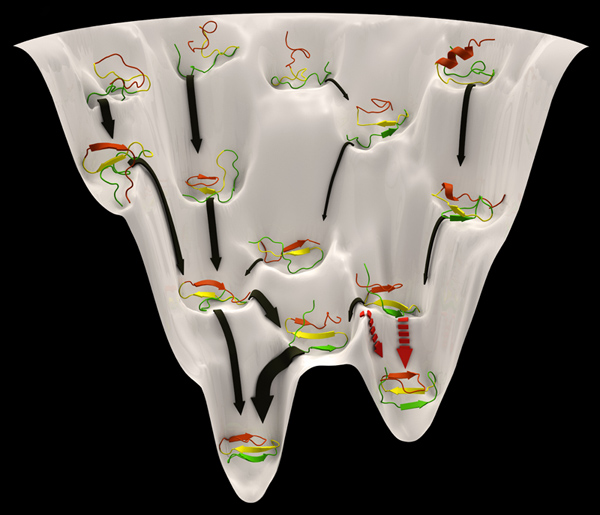Page 1 of 1
Number of misfolds
Posted: Sat May 04, 2013 4:04 pm
by stevedking
For any given single protein I understand there is only one correct fold, but how many mis-folds can there be? I'm assuming it is a very large number?
Re: Number of misfolds
Posted: Sat May 04, 2013 4:53 pm
by Jesse_V
I'm not sure about misfolds, but actually there are many ways that the protein can fold. Here is an illustration of some of the top 15 most active folding pathways for ACBP, a helix-bundle protein 86 amino acids in length. F@h folded this protein and the PG used their MSMBuilder software to construct a Markov State Model as more and more WUs come back.

You can see the full image at
http://en.wikipedia.org/wiki/File:ACBP_ ... @home.tiff which is described in the F@h article on Wikipedia and in
http://www.ncbi.nlm.nih.gov/pubmed/22747188. Only a small number of intermediate states is shown in the illustration; the real model has 2000 macrostates. One of the brilliant things about the PG's MSM software is that they can sort of zoom out to get the big picture or zoom in on some of the details.

Four numbers are used to identify a WU. The last three (Run, Clone, Generation) are used to describe where the WU is in this model. You can find a detailed explanation of what those numbers mean and how the simulation works as a whole on the Simulation FAQ:
http://folding.stanford.edu/English/FAQ-Simulation
Re: Number of misfolds
Posted: Sat May 04, 2013 5:07 pm
by stevedking
I read somewhere that it was on the order of 10^39 possible "folds" but only 1 out of 10^39 is a stable state
Re: Number of misfolds
Posted: Sat May 04, 2013 6:01 pm
by Jesse_V
stevedking wrote:I read somewhere that it was on the order of 10^39 possible "folds" but only 1 out of 10^39 is a stable state
Not sure about that. Any chance you have a source on that?
Those figures remind me of Levinthal's paradox, a thought experiment that had huge implications to the protein folding fields.
http://en.wikipedia.org/wiki/Levinthal%27s_paradox A significant number of the F@h papers mention that paradox in their introductions.
Re: Number of misfolds
Posted: Sat May 04, 2013 9:00 pm
by bruce
The single "stable state" concept is fundamentally true for most proteins, but not in every case. First, it must be noted that that picture is a 2-D projection of mathematics which actually has hundreds of thousands of dimensions. Let's add on more dimension to that picture. Imagine that you stretch the image across a surface which has a complex variety of elevations -- mountains, valleys, passes, plains but you can't see them because they're pointed at you. The arrows and the protein states shown are the only clues to those shapes. The states shown are like lakes and the arrows are like rivers. Water which starts out in the left-most (unfolded) state tends to flow to the right-most (stable, folded) state. ( .... and most of the water follows the big rivers.). The stable state on the right is sort of like the ocean. When water flows into the ocean, everywhere else is uphill from there.
Note that some lakes have only small streams leaving them. That probably means that water can remain in that lake for a long time before it finds its way out.
Now imagine redrawing the "complete map" including many, many more lakes and streams, not just the 15 most active states. Certainly some of the new lakes will have even smaller or fewer rivers leaving them and a drop of water entering that lake can conceivably get "stuck" there for a "long time." We might even find a "dead sea" where all paths are essentially into that lake and all rivers from there point uphill -- but its still not the primary destination I called the ocean. That would be that more than one stable state.
Re: Number of misfolds
Posted: Sat May 04, 2013 10:11 pm
by Jesse_V


Amyloid fibers are associated with Alzheimer's.


